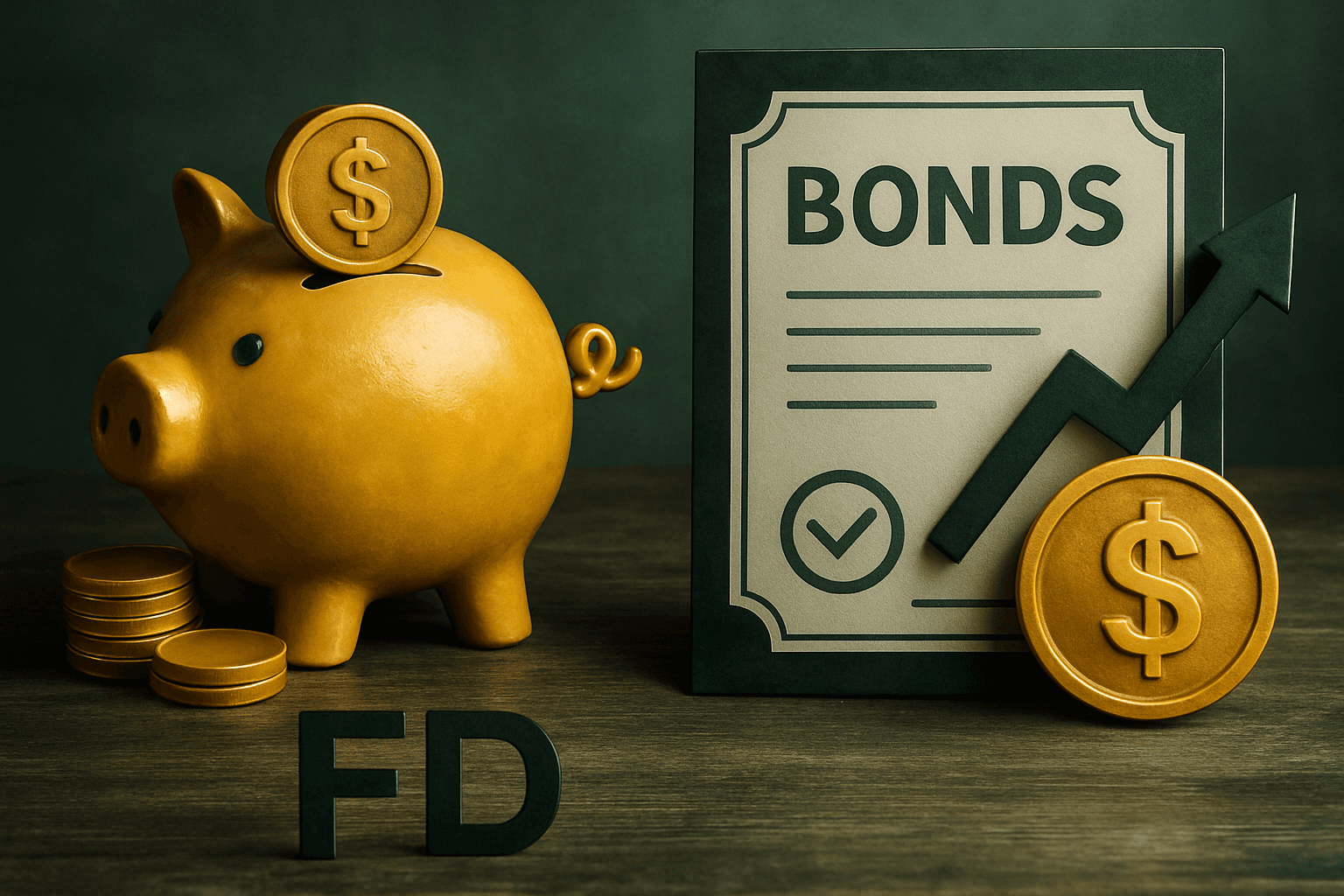Bond Investment Basics: A Beginner's Guide to Bonds
Bonds are fundamental building blocks of any well-diversified investment portfolio. As a beginner investor, understanding bonds can help you balance risk and return while generating steady income. This comprehensive guide will walk you through everything you need to know about bond investing, from basic concepts to practical strategies.
What is a Bond?
A bond is essentially an IOU – when you buy a bond, you're lending money to the issuer (government, corporation, or municipality) for a specified period. In return, the issuer promises to pay you regular interest payments (coupons) and return the principal amount (face value) when the bond matures.
Key Bond Terminology
Face Value (Par Value)
The amount the bond will pay back at maturity, typically ₹1,000 or ₹10,000 in India.
Coupon Rate
The annual interest rate paid on the bond's face value.
Maturity Date
When the bond expires and the principal is repaid.
Yield to Maturity (YTM)
The total return you'll receive if you hold the bond until maturity.
Types of Bonds Available in India
1. Government Bonds (G-Secs)
Issued by the Central or State governments, these are the safest bonds with virtually no default risk.
- Treasury Bills (T-Bills): Short-term (up to 1 year)
- Government Securities: Medium to long-term (2-40 years)
- State Development Loans (SDLs): Issued by state governments
2. Corporate Bonds
Issued by companies to raise capital. They typically offer higher yields than government bonds but carry higher credit risk.
3. Tax-Free Bonds
Issued by government entities, these bonds offer tax-free interest income but have long tenures (10-20 years).
4. Inflation-Indexed Bonds
The principal and interest payments are adjusted for inflation, protecting your purchasing power.
5. Zero-Coupon Bonds
Sold at a discount to face value, these bonds don't pay regular interest but provide returns through capital appreciation.
Understanding Credit Ratings
Credit rating agencies like CRISIL, ICRA, and CARE rate bonds based on the issuer's creditworthiness:
- AAA: Highest safety, lowest risk
- AA: High safety
- A: Adequate safety
- BBB: Moderate safety
- Below BBB: Higher risk, higher yield
How to Calculate Bond Yields
Current Yield
Current Yield = (Annual Coupon Payment / Current Market Price) × 100
Yield to Maturity (YTM)
YTM is more complex and considers the bond's current price, face value, coupon payments, and time to maturity.
Factors Affecting Bond Prices
Interest Rate Risk
When interest rates rise, bond prices fall, and vice versa. This inverse relationship is fundamental to bond investing.
Credit Risk
The risk that the issuer might default on payments. Higher-rated bonds have lower credit risk.
Inflation Risk
Inflation erodes the purchasing power of fixed coupon payments.
Liquidity Risk
Some bonds may be difficult to sell before maturity without significant price concessions.
Bond Investment Strategies
1. Buy and Hold
Purchase bonds and hold them until maturity, focusing on the coupon income and principal repayment.
2. Bond Laddering
Create a portfolio of bonds with staggered maturity dates to provide regular income and reinvestment opportunities.
3. Duration Matching
Match your bond portfolio's duration with your investment horizon to minimize interest rate risk.
4. Barbell Strategy
Combine short-term and long-term bonds while avoiding intermediate maturities.
How to Invest in Bonds
Direct Investment
- Primary market: Through bank branches or online platforms during issuance
- Secondary market: Through stock exchanges or bond trading platforms
Indirect Investment
- Bond mutual funds or ETFs
- Debt mutual funds
Tax Implications
- Interest Income: Taxable as per your income tax slab
- Capital Gains: Short-term (less than 3 years) taxed as income; long-term at 20% with indexation
- Tax-Free Bonds: Interest income is completely exempt from tax
Building Your First Bond Portfolio
Start with high-quality government bonds or AAA-rated corporate bonds, diversify across different issuers and maturities, consider your risk tolerance and investment horizon, and don't put all your money in bonds – maintain a balanced portfolio.
💡 Pro Tip: Begin with government bonds to understand how bond investing works, then gradually explore corporate bonds and other varieties as you gain experience and confidence.
Related Articles

FD vs Bonds: Which is better for you?
In the FD vs Bonds debate, understanding risk and return is key. FDs offer guaranteed returns with l...
Read More →
Exploring the concept of digital gold and its significance
Digital gold is revolutionizing how we invest in precious metals. Learn about the benefits, risks, a...
Read More →